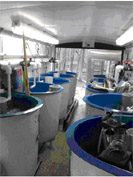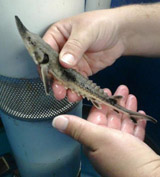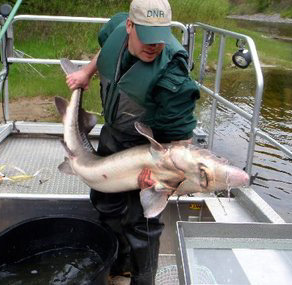|
|||||||||
 |
news archive |
The
Kalamazoo River Sturgeon Habitat Restoration Project EMAIL: ronaldc1@juno.com 3131 57th St. - Fennville, MI 49408 |
|||||||
|
|
|||||||||
|
previous news archive: APRIL 16, 2013 - News From the River’s Mouth About This Season’s Sturgeon Arrival by Ron Clark April 12, 2013. Since March 11, Kregg Smith, Senior Fisheries Biologist for the DNR and sturgeon guru, helped by Jason Lorenz, Environmental Technician with the Gun Lake Indian Tribe’s Environmental Division and Tanner Sommerfeld, DNR worker, and at times by yours truly Ron Clark of KS4T (Kalamazoo Sturgeon for Tomorrow), has been netting at the mouth of the Kalamazoo River in search of Sturgeon returning to the River to spawn as well as taking a census of walleye, suckers, steelhead and catfish. Early in the morning, we have been going out and placing two 300 foot drift-nets across the river, one just inside the breakwater and one about 100 yards further upstream. The nets are large mesh nylon designed to catch large fish and let the smaller ones swim through. The nets hang down 8 feet and are supported by floats on one side and weighted down by lead line on the other. Fish are caught in the mesh as they swim through. The nets are set and then left for several hours before they are lifted and then set again. At the same time, nets were being set on the Grand River, but yours truly did not go out on the Grand. The routine was that the nets were dropped and left the first day. Kregg and his crew would then go up and do the same on the Grand. They would then return to the Kalamazoo and lift the nets there, census what was in them and set them again. They would then come back the next day to the Kalamazoo, lift, census and drop, and then go up to the Grand, where they would do the same thing. They would then return to the Kalamazoo and repeat the process. The nets would then be left overnight to be pulled again the next day. The first week yielded virtually no fish. It was just too cold. I can attest to that, believe me. The second week, however, we caught a sturgeon on each of the five days and on one day caught 2. The female we caught was about 80 years old. The males ranged in age from 20 to 60. They were between 150 and 180 centimeters (about 5 to 6 feet) long. At the same time we caught quite a few large carp, a large variety of shovel nosed and channel catfish and 8 to 10 steelhead. This last week, we did not net any sturgeon. For the past few days during the torrential rains, the nets have been filled with leaves and sticks. The nets are designed to be invisible to the fish as the nylon mesh has no color, but the sticks, leaves and debris that fills the net cause it to appear to be a wall to the fish, and they either swim around it or stay put. A number of days have been spent cleaning and repairing nets. All of the sturgeon netted were new to Kregg (none had been tagged or clipped before), but apparently are a part of the Kalamazoo population. They had not been tagged before, which was the previous practice when fish were caught. Our population may be up to 100, which is a good thing since an estimate several years ago had it at about 30. We boated the sturgeon, went ashore, placed an electronic tracking device in them and sent them on their way, putting them back in the water far enough upstream to assure that they do not get caught in the nets again. We are all optimistic this year that we can have another spectacular release event in September. The community has not forgotten the 2011 release with over 600 people to witness it, in spite of the fact that we did not release any last year. We may never know if there was any reproduction last year. There were sturgeon in the river and even at the dam. There were females with eggs and males anxious to do their thing. We just did not get any eggs or young ones to give a boost to in our rearing station. THE REARING STATION IS BACK IN NEW RICHMOND and is awaiting our efforts on the river over the next few months. Yesterday, Kregg Smith, Senior Fisheries Biologist for the DNR, sent this for all our members and followers of the sturgeon: “I just wanted to let everyone know our tentative schedule for the remaining month of April and into May. Each Monday we will attempt to collect mature adults below Calkins Dam (Allegan Dam) on the Kalamazoo River for taking eggs and spawning fish for the hatchery. We will then work on Tuesdays through Friday for collecting naturally spawned eggs on the mats below the dam and checking gill nets on the Grand River at Grand Haven. Because of the dirty water this week, we will only work on the Kalamazoo River. Starting on May 7 we will begin our nightly larval drift sampling only on the Kalamazoo River. Some additional gill netting will occur at night when water levels are low near the Calkins Dam. Feel free to contact me by phone if you should want to volunteer to assist us.” Also, yesterday, Kregg, Jason and Tanner were on the Kalamazoo at the dam shocking fish to see if any sturgeon had come that far. None have, though they saw a lot of steelhead, walleye and long nosed suckers. These fish are a sign that spawning has begun. Sturgeon are not far behind. One young male, which we had netted a week or so ago and implanted with a transmitter down by the River mouth over a week ago was detected still hanging out down there. |
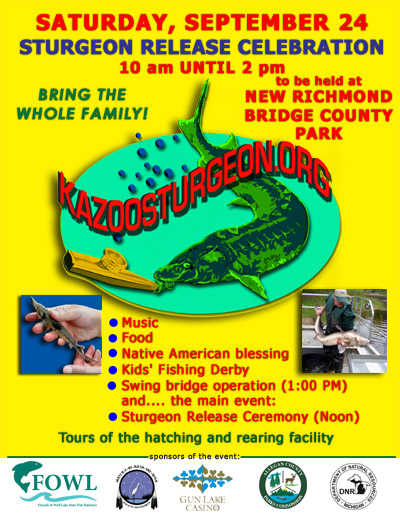 |
Press Release From Join friends and neighbors for a momentous environmental occasion! Hatchery-raised lake sturgeons will be released into the Kalamazoo River during a celebration from 10 a.m. to 2 p.m. Saturday, September 24, at New Richmond Bridge County Park, 3160 Old Allegan Road, Fennville, Michigan. There is no charge for this event that includes the sturgeon release, tours of the hatching and rearing facility, music, food, the opening of the swing bridge walkway, and a children's fishing derby. Fishing equipment and bait provided. With the sturgeon release planned for 12 noon, there will be a Native American blessing from members of the Match-e-be-Nash-She-Wish Band of the Pottawatomi Indians of the Gun Lake Tribe who have been intimately involved in this effort to raise and release these young sturgeons into the river. "There are certain roles and responsibilities of all the clans, and we as Anishinabe people respect the relationship we have with the natural world," Tribal Councilwoman Punkin Shananaquet said. "Dodem or Clan which literally means from 'whence breast I come' and is part of who we are as Anishinabek - (Potawatomi, Ojibwe, and Odawa) or the Three Fires Confederacy. It is another form of family and tribal kinship that form our framework of government and way of being or life." "There is also a cultural connection that predates this project," Liz Binoniemi-Smith, the Match-e-be-Nash-She-Wish Band's Environmental Director said. Tribal Councilwoman Shananaquet explained that the "Name" or Sturgeon Clan is referred to as the Ogema or Chief Clan of the fish pantheon along with theTurtle that also holds the title of Chief or "King." The Fish Clan people or Water Clans, as they are often referred to, are considered the philosophers and spiritualists; those who interpret and provide spiritual knowledge and guidance. Colors for the clan are "animate" meaning they move and provide life, and are blue, green and silver. Fish Clan people are often regarded as mediators in tribal disputes with their words and/or decisions being final. |
|||
|
As Councilwoman Shananaquet
continued detailing this unique cultural connection, she said,
"We observed upon the thousands of generations in the existence
of the fish and how important a role they have with the water,
the lakes, the creeks and streams. The survival of water is critical
with the inhabitants of those who live within that environment". "The Tribal approach to sustainable management of resources is to recognize the impact that current actions will have on the next seven generations. The long life of the sturgeon requires management of resources with this forward looking approach." Ms Binoniemi-Smith added. These newly released sturgeons will stay in Kalamazoo Lake, spending most of the fall and winter in this water before migrating into Lake Michigan. The hatchery, a mobile rearing facility, operated by the Michigan Department of Natural Resources, is located at New Richmond on the north side of the river at the edge of the park's boat launch site. Water drawn from the Kalamazoo River is circulated into the fish holding tanks. As the fish have developed from the eggs captured in the larval drift earlier this year into the 8 to 10 inch length fish that will be released on September 24th, they are imprinted from this particular river's environmental code and return to this portion of the Kalamazoo River where they were released to spawn. Female sturgeons may live to be 80 years of age; males, 65 years. With the females having to be approximately 20 years old before they spawn, it is important to capture and raise significant numbers of males and female sturgeons. The males live in Lake Michigan until about the age of 12 years before they return to their breeding ground to spawn. Sturgeons were once found extensively throughout the Great Lakes; however, they are now a threatened and protected species and are found infrequently in these waters. They are slow growers, but can reach significant weight up to 300 pounds and have a life expectancy of anywhere from 60 to 100 years. "The mission of the Kalamazoo River Sturgeon for Tomorrow, New Richmond Chapter is to support the reestablishment and maintenance of a healthy, self-sustaining Lake Sturgeon population in the Kalamazoo River system by assisting fisheries managers, promoting public education, furthering scientific research, and engaging in other activities consistent with Sturgeon rehabilitation," said Al Weener, the organization's president. Along with the Match-e-be-Nash-She-Wish Band of the Pottawatomi Indians of the Gun Lake Tribe, other sponsors of this sturgeon release celebration include the Kalamazoo River Sturgeons for Tomorrow, The Allegan County Parks Commission, the Michigan Department of Natural Resources, and Friends of the Wolf Lake State Fish Hatchery.
|
||||
|
|||||||||
|
Sturgeons are a species of fish that appeared about 200 million years ago. “Just before the turn of the century it was the dominant fish species in the Great Lakes,” Ricco said. That’s not true anymore. It’s believed there are only two mature females in the Kalamazoo River. Sturgeon fishing in the river is banned, Ricco said. Sturgeons can live for more than a century. Females reach maturity at somewhere between 20 and 27 years of age, while males mature between the ages of 12 and 17. The fish can weigh more than 200 pounds and be more than 7 feet in length. Populations have declined due to pollution, dams, habitat destruction and overfishing. The effort is hoped to restore the native sturgeon population in the river to a sustainable level. First, the DNR started with eggs from the river. “This year, they were able to harvest 350 to 375 fertilized eggs,” Ricco said, which isn’t many. From that, they began raising the eggs at a trailer at the New Richmond Bridge. Many died. “There’s 115 juveniles that will be released at the Kalamazoo River,” Ricco said. That will take place take place during the release ceremony, set for noon on celebration day. The day will begin with interpretative tours of the operation and a kids fishing derby. At 1 p.m. will be a bridge turning, reflecting the days when the New Richmond Bridge, now a walking bridge, was a turntable bridge that rotated to allow riverboats through. Along with the turning will be bluegrass music, food and Native American dances. The event still needs volunteers, Ricco said. Interested people can e-mail kazoosturgeon@gmail.com or call Suzanne Dixon at 616-335-5076. 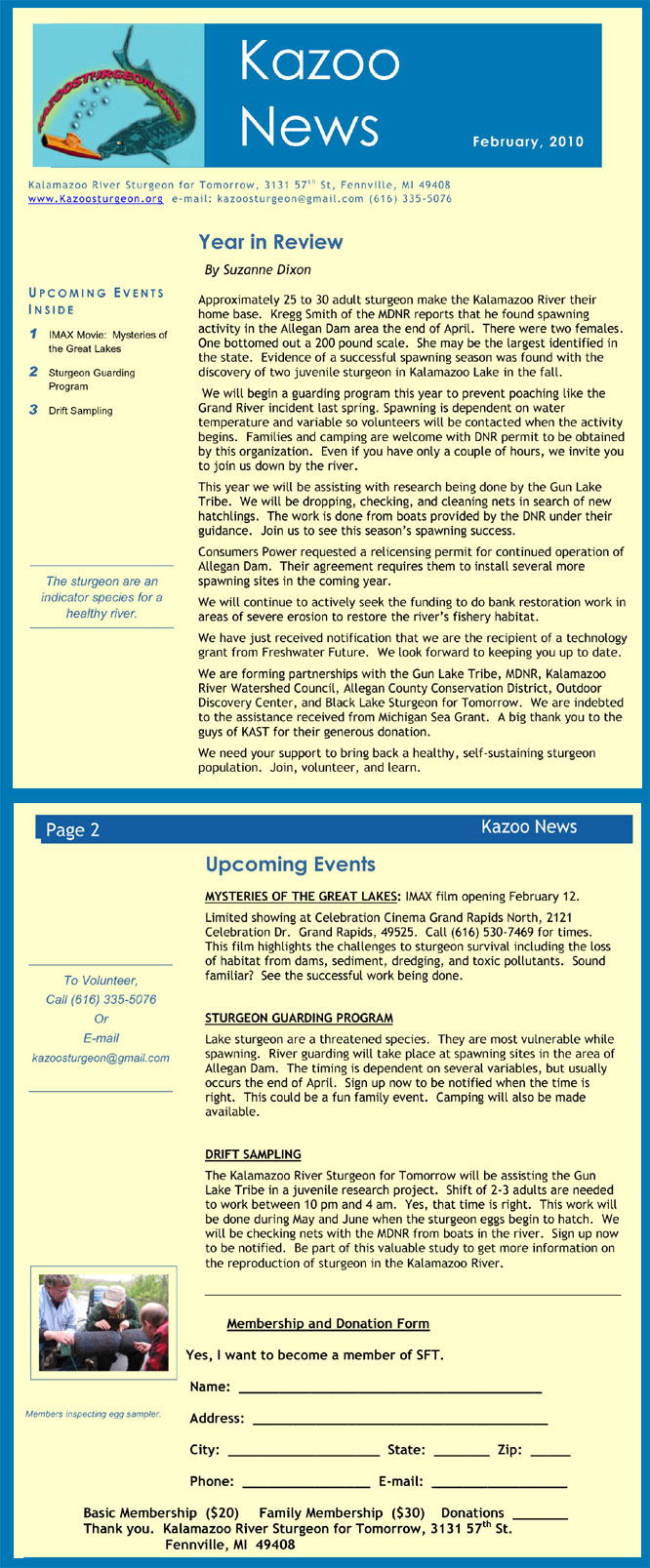 |
|||||||||
|
|||||||||
|
|
|||||||||
